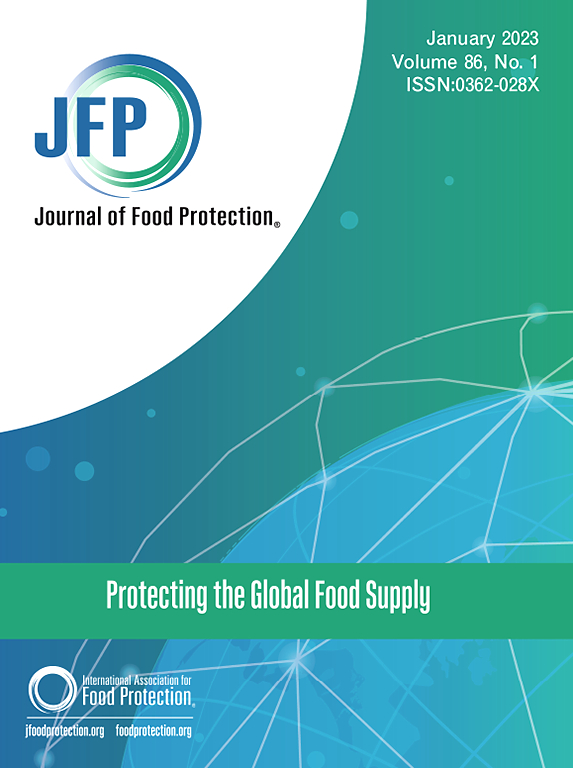产气荚膜梭菌孢子污染日本零售食品。
IF 2.1
4区 农林科学
Q3 BIOTECHNOLOGY & APPLIED MICROBIOLOGY
引用次数: 0
摘要
采用培养法和PCR法分析产气荚膜梭菌毒素基因(cpa和cpe),调查产气荚膜梭菌孢子对日本零售食品和动物肠道内容物的污染情况。产气荚膜原肠毒素在贝类12.3%(8/65份)、干海产品8.4%(7/83份)、咖喱混合物和香料7.4%(15/204份)、干海藻2.6%(1/39份)、鱼虾2.5%(2/79份)、鸡肉1.9%(2/105份)和根茎类蔬菜0.8%(1/121份)中检出。在牛肉(95份)和猪肉(110份)中未检出产肠毒素产气荚膜杆菌。产肠毒素产气荚膜菌阳性的比例在所有产气荚膜菌阳性的样品中最高,分别为鱼虾(40.0%)、咖喱混合物和香料(19.0%)、贝类(18.1%)、海产品干(16.7%)和海藻干(16.7%)。虽然在牛(212份)、猪(207份)和鸡(159份)的肠道内容物中检测到了产气荚膜杆菌,但未检出产肠毒素产气荚膜杆菌。这些结果表明,在日本销售的牛肉和猪肉不太可能受到产肠毒素产气荚膜梭菌的污染,而咖喱粉、贝类和干海产品等其他食品更可能是日本的污染源。在日本和其他亚洲菜肴中,干海产品经常被用来做汤。在与产气荚膜杆菌污染的日本和亚洲菜肴有关的食源性疾病病例中,除了肉类等其他成分外,还应调查干海鲜。本文章由计算机程序翻译,如有差异,请以英文原文为准。
Contamination of Japanese Retail Foods With Enterotoxigenic Clostridium Perfringens Spores
The contamination of Japanese retail foods and the intestinal contents of animals with the spores of enterotoxigenic Clostridium perfringens were investigated by analyzing clostridial toxin genes (cpa and cpe) using a culture method and PCR. Enterotoxigenic C. perfringens was detected in 12.3% (8/65 samples) of shellfishes, 8.4% (7/83 samples) of dried seafoods, 7.4% (15/204 samples) of curry mixes and spices, 2.6% (1/39 samples) of dried seaweeds, 2.5% (2/79 samples) of fishes and shrimp, 1.9% (2/105 samples) of chicken, and 0.8% (1/121 samples) of root vegetables. Enterotoxigenic C. perfringens was not detected in beef (95 samples) and pork (110 samples). The ratio of enterotoxigenic C. perfringens-positive to all C. perfringens-positive samples was high for fish and shrimp (40.0%), curry mixes and spices (19.0%), shellfish (18.1%), dried seafood (16.7%), and dried seaweed (16.7%). Although C. perfringens was investigated in the intestinal contents of cattle (212 samples), pigs (207 samples), and chicken (159 samples), enterotoxigenic C. perfringens was not detected. These results indicate that beef and pork sold in Japan are unlikely to be contaminated with enterotoxigenic C. perfringens, and that other foods such as curry powder, shellfish, and dried seafoods are more important as the sources of contamination in Japan. Dried seafoods are frequently used to make soup stock in Japanese and other Asian dishes. In cases of food-borne illness linked to C. perfringens contamination of Japanese and Asian dishes, dried seafood should be investigated, in addition to other ingredients such as meat.
求助全文
通过发布文献求助,成功后即可免费获取论文全文。
去求助
来源期刊

Journal of food protection
工程技术-生物工程与应用微生物
CiteScore
4.20
自引率
5.00%
发文量
296
审稿时长
2.5 months
期刊介绍:
The Journal of Food Protection® (JFP) is an international, monthly scientific journal in the English language published by the International Association for Food Protection (IAFP). JFP publishes research and review articles on all aspects of food protection and safety. Major emphases of JFP are placed on studies dealing with:
Tracking, detecting (including traditional, molecular, and real-time), inactivating, and controlling food-related hazards, including microorganisms (including antibiotic resistance), microbial (mycotoxins, seafood toxins) and non-microbial toxins (heavy metals, pesticides, veterinary drug residues, migrants from food packaging, and processing contaminants), allergens and pests (insects, rodents) in human food, pet food and animal feed throughout the food chain;
Microbiological food quality and traditional/novel methods to assay microbiological food quality;
Prevention of food-related hazards and food spoilage through food preservatives and thermal/non-thermal processes, including process validation;
Food fermentations and food-related probiotics;
Safe food handling practices during pre-harvest, harvest, post-harvest, distribution and consumption, including food safety education for retailers, foodservice, and consumers;
Risk assessments for food-related hazards;
Economic impact of food-related hazards, foodborne illness, food loss, food spoilage, and adulterated foods;
Food fraud, food authentication, food defense, and foodborne disease outbreak investigations.
 求助内容:
求助内容: 应助结果提醒方式:
应助结果提醒方式:


